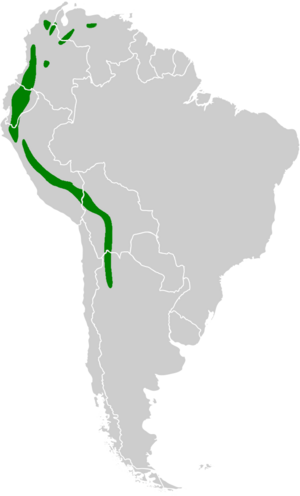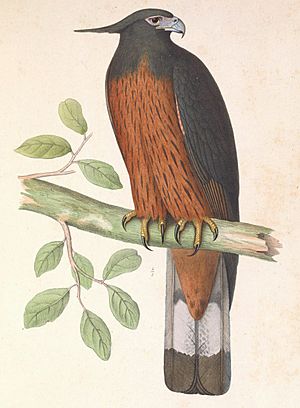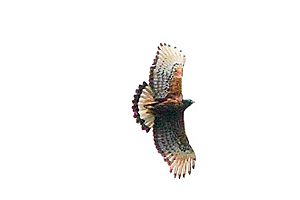Black-and-chestnut eagle facts for kids
Quick facts for kids Black-and-chestnut eagle |
|
|---|---|
 |
|
| Conservation status | |
| Scientific classification | |
| Genus: |
Spizaetus
|
| Species: |
isidori
|
 |
|
| Synonyms | |
|
Oroaetus isidori (Des Murs, 1845) |
|
The black-and-chestnut eagle (Spizaetus isidori) is a large bird of prey. It lives in South America. This powerful bird belongs to the Accipitridae family, which includes eagles and hawks. Sometimes, people call it Isidor's eagle.
Scientists used to think this eagle was in its own group, Oroaetus. But new genetic tests show it's closely related to other Spizaetus eagles. So, it is now part of that group.
Contents
About the Black-and-Chestnut Eagle
This eagle is quite big. It can be from 60 to 80 cm (24 to 31 in) long. Its wings can spread from 147 to 180 cm (4 ft 10 in to 5 ft 11 in) wide. It is the largest eagle in its Spizaetus group.
Black-and-chestnut eagles usually weigh between 1.5 to 3.5 kg (3.3 to 7.7 lb). This makes them one of the heavier eagles in their region. Only the harpy eagle is much bigger in South America.
Female eagles are usually bigger than males. This is common for birds of prey. Their strong legs and huge talons help them catch prey. Their main killing claw is almost as big as a golden eagle's.
What Does It Look Like?
Adult black-and-chestnut eagles are easy to spot. Their head and back are shiny black. Their belly and legs are a rich, streaky chestnut color. The tips of their wing feathers are black and white. This creates a strong contrast with the chestnut parts.
Their tail is grayish with a thick black band near the end. Adults have bright orange-yellow eyes. Their beak is gray, and their feet are yellow.
Young eagles look very different. They are whitish on their head and body. Their back is scaly gray-brown. Their wings are whitish where adults are chestnut. Young eagles also have two clear black bands on their tail. Their eyes are blue-gray, changing to yellow, then orange as they grow up. It takes about four years for them to become fully adult.
You can tell them apart from other eagles. The black hawk-eagle is smaller. Other young Spizaetus eagles are also smaller and less bulky. The solitary eagle looks different too, with no chestnut color.
Life in the Wild
Black-and-chestnut eagles build very large nests. They use sticks to make them about 2 m (6.6 ft) wide. Nests can be 1 m (3.3 ft) deep. They build nests in February and March. Eggs are laid in April and May. Young eagles are ready to fly by August or September.
Usually, one or two young eagles hatch. The female eagle does most of the nesting work. She builds the nest and sits on the eggs. The male eagle brings food for her and the chicks. After the chicks hatch, the female feeds and protects them. The male continues to bring food. This is a common way for eagle parents to share duties.
What Do They Eat?
These eagles hunt mostly in the forest treetops. They often soar high in the sky. They rarely perch in the open. Their strong legs and talons are perfect for catching large prey.
Their main food is small to medium-sized mammals that live in trees. This includes red-tailed squirrels and opossums. They also eat stump-tailed porcupines. Sometimes, they hunt bigger animals like kinkajous and coatis. They even catch monkeys, such as gray-bellied night monkeys.
Birds are also an important part of their diet. They often eat large forest birds called guans. This includes Andean guans. Smaller birds like Band-tailed pigeons are also hunted.
Sometimes, these eagles hunt chickens from farms. This can cause problems with people. A study in Colombia showed that chickens were part of their diet. But wild Andean guans were eaten much more often.
Black-and-chestnut eagles usually live in different areas than other large forest eagles. This means they are often the top bird predator in their home. They can even live near the solitary eagle. The solitary eagle mostly eats snakes, while the black-and-chestnut eagle prefers mammals and birds. This helps them share the same area without fighting.
Where They Live and Their Future
Black-and-chestnut eagles live in humid montane forests. These are mountain forests. They are usually found at heights between 1,800 to 2,500 m (5,900 to 8,200 ft). Their home stretches along the Andes mountains. This includes countries like Argentina, Bolivia, Peru, Ecuador, Colombia, and Venezuela.
These eagles are rare and live in specific areas. Sadly, their numbers are going down fast. The main reason is logging and deforestation. People are cutting down the forests where these eagles live. This takes away their homes and hunting grounds.
Scientists believe there are only about 370 to 1500 black-and-chestnut eagles left. Even fewer are adults ready to have chicks. This makes them one of the most endangered birds of prey in the Americas. Also, some people still hunt them because they sometimes catch farm chickens. Protecting their forest homes is very important for their survival.
See also
 In Spanish: Águila poma para niños
In Spanish: Águila poma para niños





